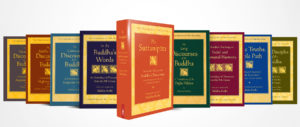
Teachings of the Buddha
The Definitive Translation of the Pāli Canon
Teachings of the Buddha
Discover the best-selling series the Teachings of the Buddha. To ensure that the Buddha’s legacy would survive the ravages of time, his direct disciples compiled records of his teachings soon after his passing. In the Theravāda Buddhist tradition, which prevails in Sri Lanka and Southeast Asia, these records are regarded as the definitive “word of the Buddha.” Preserved in Pāli, an ancient Indian language closely related to the language that the Buddha spoke, this full compilation of texts is known as the Pāli Canon.
At the heart of the Buddha’s teaching were the suttas (Sanskrit sūtras), his discourses and dialogues. The suttas were compiled into collections called “Nikāyas,” of which there are four, each organized according to a different principle. The Dīgha Nikāya consists of longer discourses; the Majjhima Nikāya of middle-length discourses; the Saṃyutta Nikāya of thematically connected discourses; and the Aṅguttara Nikāya of numerically patterned discourses.
Explore the Series
BACK IN STOCK!
The Suttanipāta
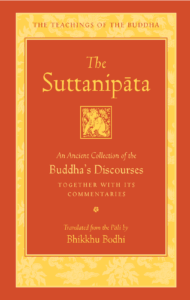 The Suttanipāta, or “Group of Discourses” is a collection of discourses ascribed to the Buddha that includes some of the most popular suttas of the Pāli Canon, among them the Loving-Kindness Sutta. The suttas are primarily in verse, though several are in mixed prose and verse. The Suttanipāta contains discourses that extol the figure of the muni, the illumined sage, who wanders homeless completely detached from the world. Other suttas, such as the Discourse on Downfall and the Discourse on Blessings, establish the foundations of Buddhist lay ethics. The last two chapters—the Aṭṭhakavagga (Chapter of Octads) and the Pārāyanavagga (The Chapter on the Way to the Beyond)—are considered to be among the most ancient parts of the Pāli Canon. The Aṭṭhakavagga advocates a critical attitude toward views and doctrines. The Pārāyanavagga is a beautiful poem in which sixteen spiritual seekers travel across India to meet the Buddha and ask him profound questions pertaining to the highest goal.
The Suttanipāta, or “Group of Discourses” is a collection of discourses ascribed to the Buddha that includes some of the most popular suttas of the Pāli Canon, among them the Loving-Kindness Sutta. The suttas are primarily in verse, though several are in mixed prose and verse. The Suttanipāta contains discourses that extol the figure of the muni, the illumined sage, who wanders homeless completely detached from the world. Other suttas, such as the Discourse on Downfall and the Discourse on Blessings, establish the foundations of Buddhist lay ethics. The last two chapters—the Aṭṭhakavagga (Chapter of Octads) and the Pārāyanavagga (The Chapter on the Way to the Beyond)—are considered to be among the most ancient parts of the Pāli Canon. The Aṭṭhakavagga advocates a critical attitude toward views and doctrines. The Pārāyanavagga is a beautiful poem in which sixteen spiritual seekers travel across India to meet the Buddha and ask him profound questions pertaining to the highest goal.
Noble Truths, Noble Path
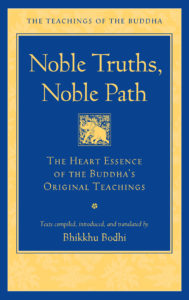 Bhikkhu Bodhi’s newest anthology is now available in paperback!
Bhikkhu Bodhi’s newest anthology is now available in paperback!
Brilliantly translated by Bhikkhu Bodhi, this anthology of suttas from the Saṃyutta Nikāya takes us straight to the heart of the Buddha’s teaching on liberation through the four noble truths and the noble eightfold path—the two mainstays of Buddhist doctrine that illuminate the nature of things by generating direct insight into the teachings. These suttas all pertain to the ultimate good, the attainment of nibbāna or liberation. They illuminate the Buddha’s radical diagnosis of the human condition—and more broadly, the condition of all sentient existence—in light of the four noble truths. They underscore the pervasive flaws inherent in the round of rebirths, trace our existential predicament to its deepest roots, and lay out the path to unraveling our bondage and winning irreversible release. Ven. Bodhi arranged the chapters, each with its own introduction, to provide an overview of the Dhamma that mirrors the four noble truths, thus enabling students of Early Buddhism to see into the heart of the Buddha’s teachings as directly and clearly as possible.
The Long Discourses of the Buddha
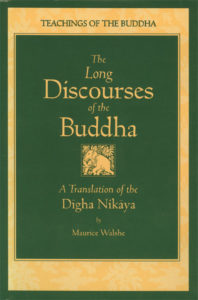 This book offers a complete translation of the Dīgha Nikaya, the long discourses of the Buddha, one of the major collections of texts in the Pali Canon, the authorized scriptures of Theravada Buddhism. This collection—among the oldest records of the historical Buddha’s original teachings, given in India two and a half thousand years ago—consists of thirty-four longer-length suttas, or discourses, distinguished as such from the middle-length and shorter suttas of the other collections.
This book offers a complete translation of the Dīgha Nikaya, the long discourses of the Buddha, one of the major collections of texts in the Pali Canon, the authorized scriptures of Theravada Buddhism. This collection—among the oldest records of the historical Buddha’s original teachings, given in India two and a half thousand years ago—consists of thirty-four longer-length suttas, or discourses, distinguished as such from the middle-length and shorter suttas of the other collections.
These suttas reveal the gentleness, compassion, power, and penetrating wisdom of the Buddha. Included are teachings on mindfulness (Mahāsatipaṭṭhāna Sutta); on morality, concentration, and wisdom (Subha Sutta); on dependent origination (Mahānidrāna Sutta); on the roots and causes of wrong views (Brahmajāla Sutta); and a long description of the Buddha’s last days and passing away (Mahāparinibbāna Sutta); along with a wealth of practical advice and insight for all those travelling along the spiritual path.
Introduced with a vivid account of the Buddha’s life and times and a short survey of his teachings, The Long Discourses of the Buddha brings us closer in every way to the wise and compassionate presence of Gotama Buddha and his path of truth.
The Middle Length Discourses of the Buddha
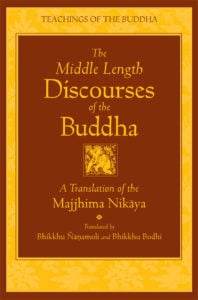 This book offers a complete translation of the Majjhima Nikāya, or Middle Length Discourses of the Buddha, one of the major collections of texts in the Pali Canon, the authorized scriptures of Theravāda Buddhism. This collection—among the oldest records of the historical Buddha’s original teachings—consists of 152 suttas or discourses of middle length, distinguished as such from the longer and shorter suttas of the other collections. The Majjhima Nikāya might be concisely described as the Buddhist scripture that combines the richest variety of contextual settings with the deepest and most comprehensive assortment of teachings. These teachings, which range from basic ethics to instructions in meditation and liberating insight, unfold in a fascinating procession of scenarios that show the Buddha in living dialogue with people from many different strata of ancient Indian society: with kings and princes, priests and ascetics, simple villagers and erudite philosophers. Replete with drama, reasoned argument, and illuminating parable and simile, these discourses exhibit the Buddha in the full glory of his resplendent wisdom, majestic sublimity, and compassionate humanity.
This book offers a complete translation of the Majjhima Nikāya, or Middle Length Discourses of the Buddha, one of the major collections of texts in the Pali Canon, the authorized scriptures of Theravāda Buddhism. This collection—among the oldest records of the historical Buddha’s original teachings—consists of 152 suttas or discourses of middle length, distinguished as such from the longer and shorter suttas of the other collections. The Majjhima Nikāya might be concisely described as the Buddhist scripture that combines the richest variety of contextual settings with the deepest and most comprehensive assortment of teachings. These teachings, which range from basic ethics to instructions in meditation and liberating insight, unfold in a fascinating procession of scenarios that show the Buddha in living dialogue with people from many different strata of ancient Indian society: with kings and princes, priests and ascetics, simple villagers and erudite philosophers. Replete with drama, reasoned argument, and illuminating parable and simile, these discourses exhibit the Buddha in the full glory of his resplendent wisdom, majestic sublimity, and compassionate humanity.
The translation is based on an original draft translation left by the English scholar-monk Bhikkhu Ñāṇamoli, which has been edited and revised by the American monk Bhikkhu Bodhi, who provides a long introduction and helpful explanatory notes. Combining lucidity of expression with accuracy, this translation enables the Buddha to speak across twenty-five centuries in language that addresses the most pressing concerns of the contemporary reader seeking clarification of the timeless issues of truth, value, and the proper conduct of life.
The Connected Discourses of the Buddha
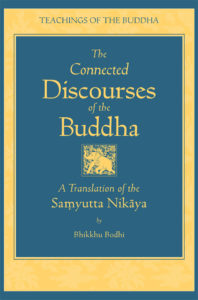 This volume offers a complete translation of the Saṃyutta Nikāya, The Connected Discourses of the Buddha, the third of the four great collections in the Sutta Piṭaka of the Pāli Canon. The Saṃyutta Nikāya consists of fifty-six chapters, each governed by a unifying theme that binds together the Buddha’s suttas or discourses. The chapters are organized into five major parts.
This volume offers a complete translation of the Saṃyutta Nikāya, The Connected Discourses of the Buddha, the third of the four great collections in the Sutta Piṭaka of the Pāli Canon. The Saṃyutta Nikāya consists of fifty-six chapters, each governed by a unifying theme that binds together the Buddha’s suttas or discourses. The chapters are organized into five major parts.
The first, The Book with Verses, is a compilation of suttas composed largely in verse. This book ranks as one of the most inspiring compilations in the Buddhist canon, showing the Buddha in his full grandeur as the peerless “teacher of gods and humans.” The other four books deal in depth with the philosophical principles and meditative structures of early Buddhism. They combine into orderly chapters all the important short discourses of the Buddha on such major topics as dependent origination, the five aggregates, the six sense bases, the seven factors of enlightenment, the Noble Eightfold Path, and the Four Noble Truths.
Among the four large Nikāyas belonging to the Pali Canon, the Saṃyutta Nikāya serves as the repository for the many shorter suttas of the Buddha where he discloses his radical insights into the nature of reality and his unique path to spiritual emancipation. This collection, it seems, was directed mainly at those disciples who were capable of grasping the deepest dimensions of wisdom and of clarifying them for others, and also provided guidance to meditators intent on consummating their efforts with the direct realization of the ultimate truth.
Great Disciples of the Buddha
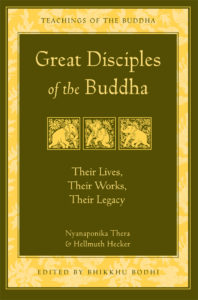 Twenty-four of the Buddha’s most distinguished disciples are brought to life in ten chapters of rich narration. Drawn from a wide range of authentic Pāli sources, the material in these stories has never before been assembled in a single volume. Through these engaging tales, we meet all manner of human beings—rich, poor, male, female, young, old—whose unique stories are told with an eye to the details of ordinary human concerns. When read with careful attention, these stories can sharpen our understanding of the Buddhist path by allowing us to contemplate the living portraits of the people who fulfilled the early Buddhist ideals of human perfection. The characters detailed include Sāriputta, Nandā, Mahāmoggallāna, Mahākassapa, Ānanda, Isidāsī, Anuruddha, Mahākaccāna, Aṅgulimāla, Visākhā, and many more.
Twenty-four of the Buddha’s most distinguished disciples are brought to life in ten chapters of rich narration. Drawn from a wide range of authentic Pāli sources, the material in these stories has never before been assembled in a single volume. Through these engaging tales, we meet all manner of human beings—rich, poor, male, female, young, old—whose unique stories are told with an eye to the details of ordinary human concerns. When read with careful attention, these stories can sharpen our understanding of the Buddhist path by allowing us to contemplate the living portraits of the people who fulfilled the early Buddhist ideals of human perfection. The characters detailed include Sāriputta, Nandā, Mahāmoggallāna, Mahākassapa, Ānanda, Isidāsī, Anuruddha, Mahākaccāna, Aṅgulimāla, Visākhā, and many more.
Conveniently annotated with the same system of sutta references used in each of the other series volumes, Great Disciples of the Buddha allows the reader to easily place each student in the larger picture of Buddha’s life. It is a volume that no serious student of Buddhism should miss.
In the Buddha’s Words
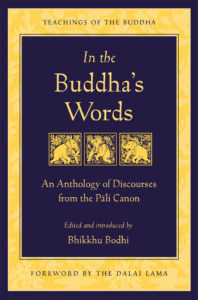 This landmark collection is the definitive introduction to the Buddha’s teachings—in his own words. The American scholar-monk Bhikkhu Bodhi, whose voluminous translations have won widespread acclaim, here presents selected discourses of the Buddha from the Pali Canon, the earliest record of what the Buddha taught. Divided into ten thematic chapters, In the Buddha’s Words reveals the full scope of the Buddha’s discourses, from family life and marriage to renunciation and the path of insight. A concise, informative introduction precedes each chapter, guiding the reader toward a deeper understanding of the texts that follow.
This landmark collection is the definitive introduction to the Buddha’s teachings—in his own words. The American scholar-monk Bhikkhu Bodhi, whose voluminous translations have won widespread acclaim, here presents selected discourses of the Buddha from the Pali Canon, the earliest record of what the Buddha taught. Divided into ten thematic chapters, In the Buddha’s Words reveals the full scope of the Buddha’s discourses, from family life and marriage to renunciation and the path of insight. A concise, informative introduction precedes each chapter, guiding the reader toward a deeper understanding of the texts that follow.
In the Buddha’s Words allows even readers unacquainted with Buddhism to grasp the significance of the Buddha’s contributions to our world heritage. Taken as a whole, these texts bear eloquent testimony to the breadth and intelligence of the Buddha’s teachings, and point the way to an ancient yet ever-vital path. Students and seekers alike will find this systematic presentation indispensable.
The Numerical Discourses of the Buddha
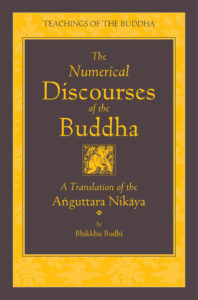 Like the River Ganges flowing down from the Himalayas, the entire Buddhist tradition flows down to us from the teachings and deeds of the historical Buddha, who lived and taught in India during the fifth century B.C.E. To ensure that his legacy would survive the ravages of time, his direct disciples compiled records of the Buddha’s teachings soon after his passing. In the Theravāda Buddhist tradition, which prevails in Sri Lanka and Southeast Asia, these records are regarded as the definitive “word of the Buddha.” Preserved in Pāli, an ancient Indian language closely related to the language that the Buddha spoke, this full compilation of texts is known as the Pāli Canon.
Like the River Ganges flowing down from the Himalayas, the entire Buddhist tradition flows down to us from the teachings and deeds of the historical Buddha, who lived and taught in India during the fifth century B.C.E. To ensure that his legacy would survive the ravages of time, his direct disciples compiled records of the Buddha’s teachings soon after his passing. In the Theravāda Buddhist tradition, which prevails in Sri Lanka and Southeast Asia, these records are regarded as the definitive “word of the Buddha.” Preserved in Pāli, an ancient Indian language closely related to the language that the Buddha spoke, this full compilation of texts is known as the Pāli Canon.
At the heart of the Buddha’s teaching were the suttas (Sanskrit sūtras), his discourses and dialogues. If we want to find out what the Buddha himself actually said, these are the most ancient sources available to us. The suttas were compiled into collections called “Nikāyas,” of which there are four, each organized according to a different principle. The Dīgha Nikāya consists of longer discourses; the Majjhima Nikāya of middle-length discourses; the Saṃyutta Nikāya of thematically connected discourses; and the Aṅguttara Nikāya of numerically patterned discourses.
The Buddha’s Teachings on Social and Communal Harmony
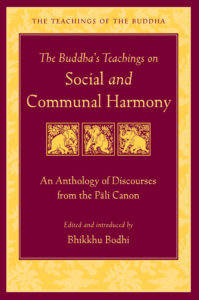 In this volume acclaimed scholar-monk Bhikkhu Bodhi has collected and translated the Buddha’s teachings on conflict resolution, interpersonal and social problem-solving, and the forging of harmonious relationships. The selections, all drawn from the Pāli Canon, the earliest record of the Buddha’s discourses, are organized into ten thematic chapters. The chapters deal with such topics as the quelling of anger, good friendship, intentional communities, the settlement of disputes, and the establishing of an equitable society. Each chapter begins with a concise and informative introduction by the translator that guides us toward a deeper understanding of the texts that follow.
In this volume acclaimed scholar-monk Bhikkhu Bodhi has collected and translated the Buddha’s teachings on conflict resolution, interpersonal and social problem-solving, and the forging of harmonious relationships. The selections, all drawn from the Pāli Canon, the earliest record of the Buddha’s discourses, are organized into ten thematic chapters. The chapters deal with such topics as the quelling of anger, good friendship, intentional communities, the settlement of disputes, and the establishing of an equitable society. Each chapter begins with a concise and informative introduction by the translator that guides us toward a deeper understanding of the texts that follow.
In times of social conflict, intolerance, and war, the Buddha’s approach to creating and sustaining peace takes on a new and urgent significance. Even readers unacquainted with Buddhism will appreciate these ancient teachings, always clear, practical, undogmatic, and so contemporary in flavor. The Buddha’s Teachings on Social and Communal Harmony will prove to be essential reading for anyone seeking to bring peace into their communities and into the wider world.
Meet the Authors & Translators
 Venerable Bhikkhu Bodhi has worked on seven of the eight books in the Teachings of the Buddha series, beginning as co-translator of The Middle Length Discourses of the Buddha; translator of The Connected Discourses of the Buddha; editor of the Great Disciples of the Buddha; editor of In the Buddha’s Words; translator of The Numerical Discourses of the Buddha; editor of The Buddha’s Teachings on Social and Communal Harmony; and translator of The Suttanipāta.
Venerable Bhikkhu Bodhi has worked on seven of the eight books in the Teachings of the Buddha series, beginning as co-translator of The Middle Length Discourses of the Buddha; translator of The Connected Discourses of the Buddha; editor of the Great Disciples of the Buddha; editor of In the Buddha’s Words; translator of The Numerical Discourses of the Buddha; editor of The Buddha’s Teachings on Social and Communal Harmony; and translator of The Suttanipāta.
Ven. Bhikkhu Bodhi is an American Buddhist monk from New York City, born in 1944. He obtained a BA in philosophy from Brooklyn College and a PhD in philosophy from Claremont Graduate School. After completing his university studies he traveled to Sri Lanka, where he received novice ordination in 1972 and full ordination in 1973, both under the leading Sri Lankan scholar-monk, Ven. Balangoda Ananda Maitreya (1896-1998). From 1984 to 2002 he was the editor for the Buddhist Publication Society in Kandy, where he lived for ten years with the senior German monk, Ven. Nyanaponika Thera (1901-1994), at the Forest Hermitage. He returned to the U.S. in 2002. He currently lives and teaches at Chuang Yen Monastery in Carmel, New York. In 2008, together with several of his students, Ven. Bodhi founded Buddhist Global Relief, a nonprofit supporting hunger relief, sustainable agriculture, and education in countries suffering from chronic poverty and malnutrition.
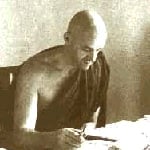 Venerable Bhikkhu Ñāṇamoli (1905–60) is the co-translator of Teachings of the Buddha series book The Middle Length Discourses of the Buddha. He was born in England and became a monk in Sri Lanka in 1949. During the eleven years he spent as a monk, he translated from Pali into lucid English some of the most difficult texts of Theravada Buddhism, including Buddhaghosa’s Path of Purification.
Venerable Bhikkhu Ñāṇamoli (1905–60) is the co-translator of Teachings of the Buddha series book The Middle Length Discourses of the Buddha. He was born in England and became a monk in Sri Lanka in 1949. During the eleven years he spent as a monk, he translated from Pali into lucid English some of the most difficult texts of Theravada Buddhism, including Buddhaghosa’s Path of Purification.
Hellmuth Hecker is the co-author of the Teachings of the Buddha series book Great Disciples of the Buddha. He is a leading German writer on Buddhism and a translator from the Pali canon. His books include a german translation of the Samyutta Nikaya (parts 4 & 5) a two-volume chronicle on Buddhism in Germany, and a biography of Ven. Nyanatiloka Mahathera, the first German Buddhist monk.
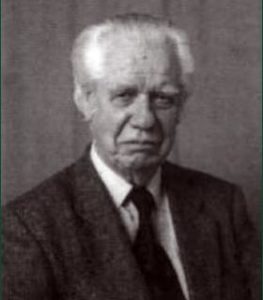 Maurice Walshe is the translator of the Teachings of the Buddha series book The Long Discourses of the Buddha. He was born in London in 1911 and was an active Buddhist from 1951 until the end of his life in 1998. He served as the Vice-President of the Buddhist Society and Chair of the English Sangha Trust. A scholar of Pali and German, his other works include Buddhism for Today and translations of the sermons of Meister Eckhart.
Maurice Walshe is the translator of the Teachings of the Buddha series book The Long Discourses of the Buddha. He was born in London in 1911 and was an active Buddhist from 1951 until the end of his life in 1998. He served as the Vice-President of the Buddhist Society and Chair of the English Sangha Trust. A scholar of Pali and German, his other works include Buddhism for Today and translations of the sermons of Meister Eckhart.
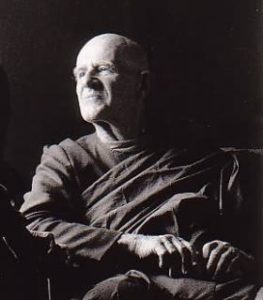 Nyanaponika Thera is the co-author of the Teachings of the Buddha series book Great Disciples of the Buddha. He was a German-born Buddhist monk, scholar, translator, and founder of The Buddhist Publication Society in Sri Lanka. Thera died in 1994 at the age of 93.
Nyanaponika Thera is the co-author of the Teachings of the Buddha series book Great Disciples of the Buddha. He was a German-born Buddhist monk, scholar, translator, and founder of The Buddhist Publication Society in Sri Lanka. Thera died in 1994 at the age of 93.

